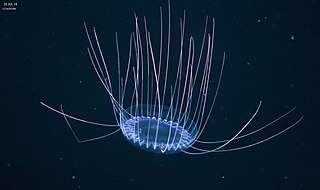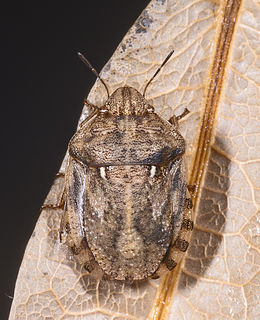
Johannes Japetus Smith Steenstrup FRS(For) HFRSE was a Danish zoologist, biologist, and professor.

Karl Gegenbaur was a German anatomist and professor who demonstrated that the field of comparative anatomy offers important evidence supporting of the theory of evolution. As a professor of anatomy at the University of Jena (1855–1873) and at the University of Heidelberg (1873–1903), Karl Gegenbaur was a strong supporter of Charles Darwin's theory of organic evolution, having taught and worked, beginning in 1858, with Ernst Haeckel, eight years his junior.

Rhizostomae or Rhizostomeae is an order of jellyfish. Species of this order have neither tentacles nor other structures at the bell's edges. Instead, they have eight highly branched oral arms, along which there are suctorial minimouth orifices. These oral arms become fused as they approach the central part of the jellyfish. The mouth of the animal is also subdivided into minute pores that are linked to coelenteron.

Max Carl Anton Fürbringer was a German anatomist, known for his anatomical investigations of vertebrates and especially for his studies in ornithology on avian morphology and classification. He was responsible for the first major phylogenetic ordering of bird groups based on a large scale study on a combination of skeletal, morphological and anatomical characteristics.

The Pelagiidae are a family of jellyfish. Members of the family Pelagiidae have no ring canal, and the marginal tentacles arise from umbrella margin.

Solmissus, or dinner plate jellyfish, is a genus of hydrozoans. Its species are unique among cnidarians in that they actively hunt for prey as opposed to passively waiting for plankton to pass by. They are found in the deep waters of Monterey Bay, California. They are most likely to be found in the deep sea, mid water. They grow to be 20 cm (7.9 in) in diameter. These hydrozoans feed on gelatinous zooplankton, including salps and doliolids, ctenophores, jellyfish, and copepods. However, Solmissus may be limited to feeding on soft-bodied prey by the type of nematocysts on their tentacles (Mills).

Julius Victor Carus was a German zoologist, comparative anatomist and entomologist.

Josef Anton von Gegenbaur was an accomplished German historical and portrait painter.

Jacques Vladimir von Bedriaga was a Russian herpetologist who was a native of Kriniz, a village near Voronezh.

Cuninidae is a family of hydrozoans in the order Narcomedusae. They have dome-shaped bells and tentacles set above the undulating margin of the bell. Their gastric pouches contain the gonads situated in line with the tentacles, the number of pouches being the same as the number of tentacles. The pouches do not extend below the points of origin of the primary tentacles. Members of some genera have a peripheral canal system and others do not. No radial canals or secondary tentacles are present.

Eurygaster maura, also known as tortoise bug, is a species of true bugs or shield-backed bugs belonging to the family Scutelleridae.

Eurygaster is a genus of shield bugs widespread in Eurasia; some in North America.

Capitata is a suborder of Hydrozoa, a class of marine invertebrates belonging to the phylum Cnidaria.

Eurygaster testudinaria is a Palearctic shieldbug. It occurs in Europe from the Northern Mediterranean to southern Scandinavia, and East through Central Asia to northern China and Japan.

Rhopalonema is a genus of deep-sea hydrozoans of the family Rhopalonematidae.
Eurygaster alternata is a species of shield-backed bug in the family Scutelleridae. It is found in North America.
Eurygaster shoshone is a species of shield-backed bug in the family Scutelleridae. It is found in North America.
Eurygaster amerinda is a species of shield-backed bug in the family Scutelleridae. It is found in North America.

Zanclea is a genus of hydrozoans belonging to the family Zancleidae.














